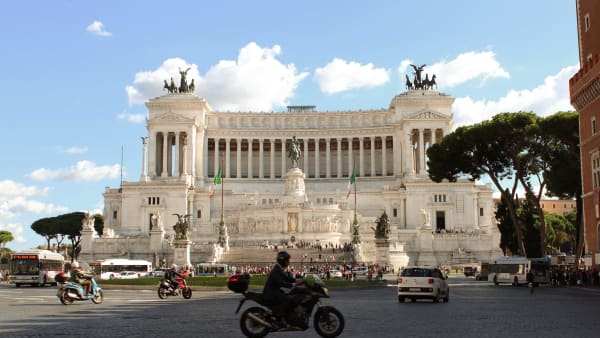Curiosities
Curiosities
The Pantheon is the Roman monument that holds the most records: it has the largest dome in the history of Roman architecture and is the best-preserved of all the ancient buildings of the great empire.
Moreover, it’s the only building that to this day, after two millennia, has retained the same (religious) function for which it was built and it’s also the most copied and imitated structure of antiquity—not only in Italy.
Eclecticism
The structure of the Pantheon encloses a set of features belonging to different cultures and worlds, merged in an unexpectedly pleasant outcome. The monument exhibits elements that recall the style of ancient Greece, that of imperial Rome, and elements typical of the first Christian basilicas.
The front view, which looks much like the façade of a Greek temple, stands in unexpected contrast to the semicircular domed roof above it. Finally, the building occupies the space behind the facade in the form of a large apse.
Also noteworthy is the contrast with the obelisk that stands opposite the monument, on Rotunda Square. This Egyptian jewel adorned the Temple of Isis in Egypt in the days of Pharaoh Ramses and is 6.43 meters high.
Architectural influence
The best-preserved monument of Roman architecture has had an enormous influence on architects around the world. Numerous civil halls, universities, and libraries exhibit characteristic elements of its structure, such as the dome.
Among the famous buildings in Italy influenced by the Pantheon, we can mention the church of the monumental cemetery of Staglieno in Genoa, the church of San Carlo al Corso in Milan, the basilica of San Francesco di Paola in Naples, the Cisternone in Livorno, the church of the Gran Madre di Dio, and St. Peter’s Basilica.
Even abroad, stylistic traces of the monument can be found. For example, in Anglo-Saxon countries, we find the Thomas Jefferson Rotunda at the University of Virginia, the library of Columbia University in New York, and the library of the State of Victoria in Melbourne, Australia. In France, on the other hand, we find Soufflot’s Pantheon in Paris.
The demon’s hole
The Oculus of the Pantheon covers several legends. For example, in the Middle Ages, it was thought to be the ancient location of the bronze pine cone that is currently in the courtyard of the Vatican Museums.
Another myth claims that it “never rains” in the Pantheon. This is because the Oculus creates an upward airflow that holds back the drops of rainwater. When it’s raining heavily outside, it appears that it’s raining less or barely at all inside. In reality, this perception is enhanced by the fact that both central and side drain holes in the floor prevent the formation of puddles.
Given the size and scope of the Oculus, it was thought that it couldn’t possibly have been built by human hands. Therefore, it’s said that the Oculus was carved by the horns of an enormous devil escaping from the temple. For this reason, it was also known as “the demon’s hole”.
On June 21 (the summer solstice), at precisely noon, the light of the sun shines through the Oculus and projects a huge disc of light onto the floor. This phenomenon symbolizes the connection between humanity and the Gods.
Also on April 21 at noon, the day when according to legend the city of Rome was founded, the sunlight falls exactly on the center of the Oculus. Because of this, the Pantheon is also called the solar or astral temple.
The immortal inscription
As mentioned in the historical section of this article, Marcus Vipsanio Agrippa had his name engraved on the facade of the Pantheon. The original inscription reads “Marcus Agrippa, Lucii filius, consul tertium fecit” meaning “Marcus Agrippa, son of Lucius, consul for the third time, built it.”
Although the monument was rebuilt under the reign of Hadrian, by the architect Apollodorus of Damascus, and several changes were made, the inscription remained faithful to the original. Two thousand years later, it’s still one of the most representative elements of the Pantheon.
The planetary gods
In the Pantheon, within the wall of the Rotunda, seven niches are placed between the Corinthian columns. These differ in shape, some are circular and others rectangular, but all are evenly arranged from the center.
In the past, these niches housed the statues of the deities of the planets: Sol Invictus, Luna, Venus, Saturn, Jupiter, Mercury, and Mars. Over the centuries, the statues were stolen or destroyed and replaced with Christian altars and monuments.
In the fictional autobiography of the Roman Emperor Hadrian (Mémoires d’Hadrien), written by the French-Belgian author Marguerite Yourcenar, the role of the Gods is described as follows “I wanted this sanctuary of all gods to represent the globe and the celestial sphere, a globe within which the seeds of eternal fire are enclosed, all contained in the hollow sphere”.
Thus the Pantheon leads us back to the theories and astronomical concepts by which the ancient Greeks and Romans interpreted celestial phenomena. Because of the vision they had of the universe and the planets, they considered each occurrence to be living personifications of the Gods.
The whole constitutes an interesting abstract of astronomy in the analysis of such theories and the parameters of comparison with modern scientific achievements in astronomical and cosmological fields. In addition, it could also reveal interesting architectural analogies in the same proportions as the grandiose and powerful monumental internal structure of the Pantheon.
Tombs
As mentioned in the historical section of this article, from the Renaissance on (as in all churches), tombs were built in the Pantheon. These belong to various important historical figures, including painters, composers, architects, etc.
One notable person buried in the monument is undoubtedly the famous painter Raffaello Sanzio, who was in charge of the works for the realization of the new St. Peter’s Basilica. He chose the Pantheon as his final resting place.
On the artist’s tomb is the famous inscription in Latin “Ille hic est Raffael, timuit quo sospite vinci, rerum magna parens et moriente mori“ which means “Here lies Raphael, by whom Mother Nature feared to be outdone while he lived, and when he died, feared that she herself would die”.
The first two kings of Italy
The tombs of the two first kings of Italy are also located here. The tomb of Vittorio Emanuele II (1820 - 1878) is in the central chapel on the right. On the other side of the Pantheon, you’ll find the tomb of his son, King Umberto I (1844 - 1900), and his wife Queen Margherita.
The tomb of Vittorio Emanuele III (1869 - 1947) is missing. The last king of Italy died after being exiled for supporting Mussolini’s regime and signing the racial laws nearly 80 years ago that brought doom to many Jewish families. The remains of the king and his wife were flown to Italy in late 2017, where they have been included in a family mausoleum in Vicoforte near Cuneo.
The rain of rose petals
In honor of the Feast of Pentecost, something special happens every year at the Pantheon. This is because the Mass that’s given concludes with a veritable rain of rose petals, an ancient tradition that provides visitors with a unique experience.
At the end of the service, firemen reach the top of the Pantheon’s dome (43 meters high) and drop around 7 million red rose petals from the Oculus. This event (on the 50th day after Easter) used to celebrate the end of the harvest and today still symbolizes the tongues of fire that the Holy Spirit sent down on Mary and the Apostles during Pentecost.
The “red rain” has been an officially reinstated tradition since 1995, which originally first took place thousands of years ago. Besides, this tradition is not only common in Rome, although the Pantheon undoubtedly gives the most spectacular example. Pentecost, especially in central and southern Italy, is also called “Rosy Easter”.
The use of rose petals in the Roman tradition, an element that’s also used on other occasions and has great symbolic value, goes way back. During the Rosalia, for example, a Roman festival in which the deceased are honored and remembered, the Romans decorated the graves of their loved ones with rose petals, rosaries, and other flowers. In addition, food was sometimes sacrificed. The Rosalia was part of the four death celebrations called solennia sacrificia (Rosalia, Parentalia, Violaria, and the birthday of the deceased) and was usually celebrated in May.
Red rose petals were also used by early Christians in memory of the blood that Christ shed on the cross for the redemption of mankind. Thus, the origin of the Pantheon tradition partly came from the symbolic meaning of the red rose and not from the white rose that symbolizes Mary.
The legend of the magician Baialardo and the devil
Around the Pantheon is a ditch from which you can see where the street level was in Roman times. According to a medieval legend, this moat was formed curiously.
It seems that the famous magician Pietro Bailardo came into possession of the Book of Commandments, which was given to him by the devil in exchange for his soul.
Then Bailardo regretted the agreement and used his magical abilities to make a one-day pilgrimage to Jerusalem, St. James of Galicia, and finally to the Pantheon. Outside the temple, he encountered the devil who came to claim his soul and fled inside to pray for forgiveness.
The devil was furious and walked around the temple countless times waiting for Bailardo to come out again. Thus he dug the moat that is still visible today.















